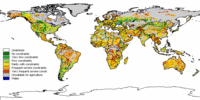Global Soil Health
Soil Health Indicators
The main soil qualities that are considered as Soil health indicators are nutrient availability, workability, oxygen availability to roots, nutrient retention capacity, toxicity, salinity and rooting conditions. They are inventoried and mapped at global scale in the Harmonized World Soil Database v1.2. The Soil Suitability at low input map (IIASA/FAO) is an example of the indicator nutrient availability.
Absolute Soil Health assessment
Absolute soil health can be defined as the deviation of the actual soil from an ideal one and corresponds with the concept of quantifying problem soils. The original Global Agro-ecological zoning study for Agriculture in the XXIst Century (note: this webpage works only with INTERNET EXPLORER) gave a global overview of soil constraints combined. A global overview of absolute soil health combining all the limitations in soil quality is given in the FAO website on Global Agro-ecological Zoning.
Relative Soil Health
The relative soil health is considered correct when soils are under natural vegetation. When used for cropped agriculture or for livestock grazing is the relative soil health evaluated according to the principles explained under soil assessment. Results at global scale are shown in the Soil health status for present land use map.
A number of areas are considered wasteland and have soil health that cannot get better or worse. This concerns soils with bedrock at the surface, salt flats, glaciers, moving sand dunes or those soils occurring in polar or desert climate. Those soils have all an extremely low absolute soil health.



